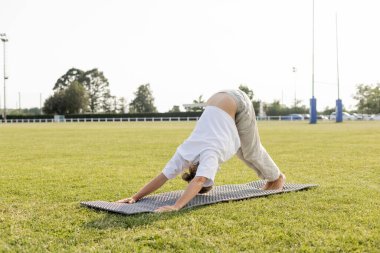Yoga Asana – The Dolphin Plank

Unleashing the Power of the Dolphin Plank: A Dive into Core Strength and Flexibility
Among the plethora of core exercises available to fitness enthusiasts, the Dolphin Plank stands out both for its unique name and its numerous benefits. If you’re looking for a twist on the classic plank that can deliver results, the Dolphin Plank might just be your new best friend.
So, what is the Dolphin Plank, and why should you incorporate it into your exercise routine? Let’s dive in!
What is the Dolphin Plank?
The Dolphin Plank is a variation of the standard plank exercise, which is a staple in many core-focused workouts.
By adding movement and extra engagement of the shoulders, it combines the benefits of the plank with those of the dolphin pose, a yoga asana. The result is an exercise that not only strengthens your core but also targets your shoulders, arms, and upper back.
How to Perform the Dolphin Plank

Starting Position: Begin in a standard forearm plank position. Place your elbows directly below your shoulders, palms flat on the ground, and legs extended straight behind you. Engage your core by pulling your navel towards your spine, and ensure that your body forms a straight line from your head to your heels.
The Movement: On an exhale, press through your forearms and palms, lifting your hips towards the ceiling, driving your chest back towards your thighs. Your body will form an inverted ‘V’ shape, similar to the downward dog pose in yoga but with your forearms remaining on the ground.
Return: Inhale and lower your hips, returning to the initial plank position, ensuring that your body remains in a straight line.
Repetitions: Aim for 10-15 reps, depending on your fitness level. As you gain strength and endurance, you can increase the number of repetitions or hold the inverted ‘V’ position for a few breaths for added intensity.
Benefits of the Dolphin Plank
Strengthened Core: Much like the standard plank, the Dolphin Plank is excellent for core strengthening. It targets the rectus abdominis, obliques, and the transverse abdominis, ensuring a well-rounded core workout.

Improved Shoulder and Upper Back Strength: By pressing the chest towards the thighs and lifting the hips, there’s increased engagement of the deltoids, trapezius, and rhomboid muscles. This added engagement helps build shoulder stability and upper back strength.
Flexibility: Incorporating the dolphin motion increases the stretch in the shoulders, hamstrings, and calves, promoting flexibility and range of motion.
Enhanced Posture: Regular engagement of the core and upper back muscles can contribute to better posture, reducing the risk of back pain and related issues.
Cardiovascular Boost: The dynamic movement of moving between the plank and the inverted ‘V’ position increases the heart rate, giving you a slight cardiovascular benefit.
Mental Benefits: As with many exercises that have their roots in yoga, the Dolphin Plank can also be a mindful practice. The focus on breathing and movement synchronization can bring about a sense of calmness and increased awareness.
The Dolphin Plank – Try It
The Dolphin Plank is a versatile exercise that provides both strength and flexibility benefits.
Whether you’re a yoga enthusiast looking to spice up your routine or someone simply seeking an effective core workout, the Dolphin Plank is worth a shot. Remember, as with any exercise, it’s crucial to maintain proper form to avoid injury and maximize benefits. If you’re new to this exercise, consider seeking guidance from a fitness professional or watching demonstration videos to ensure you’re on the right track.









